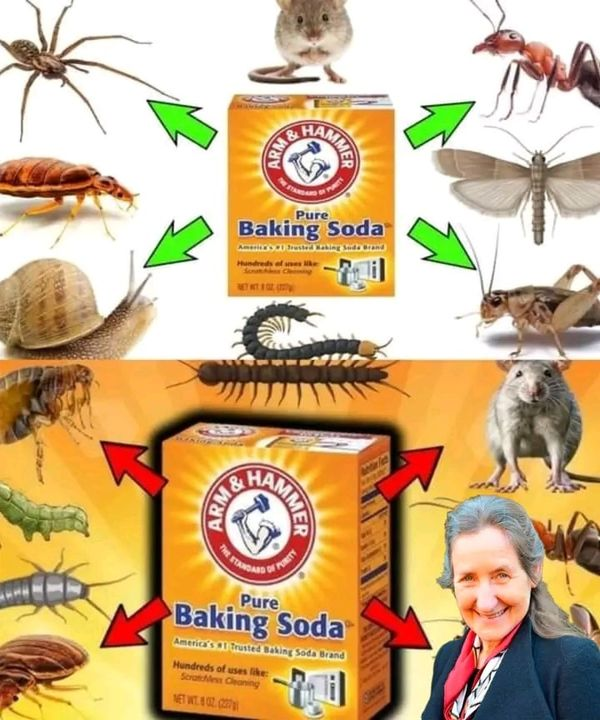
Baking soda is a versatile and eco-friendly solution to combat pests like cockroaches, fleas, ants, moths, mice/rats, and spiders. It’s safe, non-toxic, and easy to use around the home. Here’s how you can effectively use baking soda to deal with each type of pest:
1. Cockroaches
Why It Works: Baking soda reacts with the acids in a cockroach’s stomach, killing them effectively.
How to Use:
- Mix equal parts baking soda and sugar in a shallow dish or sprinkle the mixture in areas where cockroaches are active.
- The sugar attracts them, and the baking soda does the rest.
- Place the bait near cracks, under sinks, or behind appliances.
2. Fleas
Why It Works: Baking soda dehydrates fleas and their eggs.
How to Use:
- Sprinkle baking soda liberally on carpets, pet bedding, and upholstery.
- Use a stiff brush to work it into the fibers, then leave it for several hours or overnight.
- Vacuum thoroughly to remove fleas, eggs, and baking soda residue.
- Repeat weekly for effective flea control.
3. Ants
Why It Works: Baking soda interferes with ants’ digestive systems when ingested.
How to Use:
- Mix equal parts baking soda and powdered sugar.
- Sprinkle the mixture along ant trails, near entry points, and around the kitchen.
- The sugar lures ants, while the baking soda disrupts their metabolism.
4. Moths
Why It Works: Baking soda absorbs moisture and odors that attract moths.
How to Use:
- Place sachets filled with baking soda and a few drops of essential oil (like lavender) in closets, drawers, or storage boxes.
- For extra protection, sprinkle baking soda on carpets and vacuum after a few hours to deter moth larvae.
5. Mice and Rats
Why It Works: Baking soda produces gas that rodents cannot expel, which eventually kills them.
How to Use:
- Combine baking soda with peanut butter or flour to make a bait.
- Place small portions in areas where you’ve noticed rodent activity, such as along walls or in hidden corners.
6. Spiders
Why It Works: Baking soda acts as a natural deterrent for spiders.
How to Use:
- Sprinkle baking soda around the perimeter of rooms, under furniture, or in dark corners where spiders hide.
- Alternatively, mix baking soda with a few drops of peppermint essential oil for enhanced spider repellence.
Additional Tips:
- Always reapply baking soda after cleaning or vacuuming to maintain its effectiveness.
- Combine baking soda with natural deterrents like vinegar, essential oils, or diatomaceous earth for stronger pest control.
- Monitor pest activity to determine if repeated treatments are necessary.
By using baking soda, you can keep your home pest-free without resorting to harmful chemicals. It’s a simple, cost-effective, and natural solution!

There’s One Method of Healing Trauma That Prince Harry Uses, and Here’s How to Practice It
Prince Harry recently opened up about his journey with post-traumatic stress disorder following the loss of his mother, Princess Diana. In a candid discussion, he revealed his exploration of a groundbreaking therapy that helped him.

The therapy is called eye movement desensitization and reprocessing (EMDR) to address the debilitating effects of his anxiety attacks. This revelation offers a glimpse into the royal’s personal struggles and his proactive approach towards mental health care, shedding light on the significance of seeking innovative treatments of traumas.
In a video, Prince Harry can be seen undergoing EMDR therapy, where he taps his shoulders and moves his eyes rapidly. This therapy is relatively new and is used to treat PTSD. Prince Harry shared that he decided to try EMDR to deal with severe anxiety attacks he was experiencing.
Prince Harry mentioned that he was open to trying EMDR because of the therapy and work he had done over the years.

During a therapy session with UK-based psychotherapist Sanja Oakley, Prince Harry demonstrated how EMDR helped him feel better about returning home. He described feeling scared and helpless before, but the therapy helped him cope with those feelings.
Prince Harry’s openness about his experience with EMDR therapy sheds light on alternative treatments for post-traumatic disorder and mental health struggles. It shows that seeking help and trying different therapies can make a difference in managing mental health conditions.

EMDR is a therapy made in 1987 to help with emotional traumas. It’s a structured therapy where you think about a tough memory while moving your eyes back and forth. This helps lessen the strong feelings tied to the memory.
EMDR works on a theory called Adaptive Information Processing (AIP). It says that trauma sticks around because it hasn’t been dealt with properly. So, when something reminds you of the trauma, those memories can come back strongly.
Unlike other therapies that try to lessen your reaction to trauma, EMDR tries to change how your brain stores those tough memories. Sometimes, instead of eye movements, you might listen to alternating tones. Usually, EMDR happens once or twice a week for about six to 12 sessions. But it can vary depending on the person.
Benefits of EMDR therapy
- EMDR is a structured therapy and usually needs fewer sessions than ongoing therapies.
- You don’t have to keep going back to the tough memory for a long time.
- You don’t have to talk a lot about what happened to you.
- There’s no homework to do.
- EMDR doesn’t try to change your thoughts and beliefs.
Disadvantages of EMDR therapy
- While EMDR is known to help with PTSD, it hasn’t been studied as much for other mood or mental health problems.
- If you’re avoiding talking about a tough event, EMDR might not be the best choice. Other types of talk therapy might work better.
- EMDR can sometimes make you feel worse at the start of treatment. The person who created EMDR warns that this could be dangerous for people who have gone through really tough things.
The process of EMDR
EMDR is a structured process with eight phases, each aimed at helping you deal with traumatic memories:
- History taking: Discuss your past with the therapist to identify which memories to focus on.
- Preparation: Learn about EMDR and how the therapist will use bilateral stimulation.
- Assessment: Identify your negative and positive beliefs related to the trauma.
- Desensitization: Use bilateral stimulation while recalling the memory.
- Installation: Focus on positive beliefs while processing the memory.
- Body scan: Talk about how you feel emotionally and physically.
- Closure: Prepare for what may happen between sessions.
- Reevaluation: Assess your progress and decide if more sessions are needed.
As you go through EMDR, you may start feeling less overwhelmed by the trauma. It’s normal for other painful memories to surface, indicating that suppressed memories are being processed.
When grappling with deep emotional traumas, it’s crucial to seek out specialists who can provide the appropriate form of treatment tailored to your needs. Whether it’s EMDR therapy or other therapeutic approaches, finding the right professional can make a significant difference in your healing journey.
Preview photo credit Good Morning America / YouTube



Leave a Reply